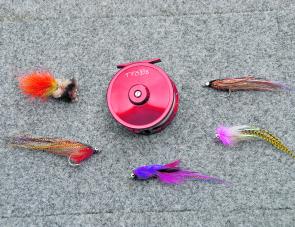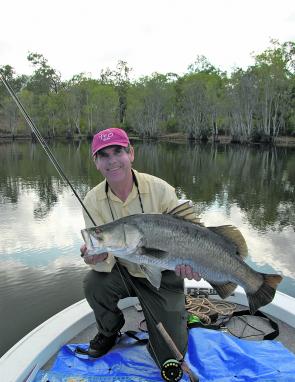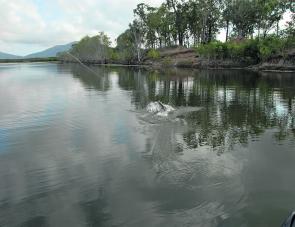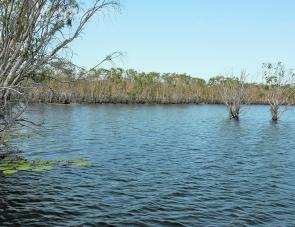It’s old news that the tidal and coastal barramundi season’s closed until February, which means there’s not even a spot of catch and release for a bit of fun because this caper upsets the vital breeding instincts of the fish.
Impoundment barra, on the other hand, are fair game as they cannot breed in dams, and for the angler wanting some top sport with the fly rod, these iconic fish are a godsend. They are not subject to tidal movement – although the jury is still locked in debate as to tidal phase influence on bite times – as they are in a closed environment, albeit a large one.
Also, when hooked, freshies offer all of the excitement of their sea run cousins. There’s the same thumping hit, usually a bit of jumping and trademark tractor like pulling. Last but not least, barra grow very big in dams and many an angler failing to catch and fulfil the dream of a metre fish in the salt will quickly round up the score sheet in the fresh water environment. Besides, skill learned at finding, hooking and playing barra in dams will stand the angler in good stead for a crack at the salties once the season opens next year.
Go for a 10wt every time, and set it up with an intermediate sink rate line, plus a spare spool having a floating line on it. If you don’t have flies, buy some size Deceivers, Gold Bombers or Bush Pigs in around a 4/0 size. I make my own and while very rough, they work. Flash and bulk is everything with barra.
Luckily, we Queenslanders are blessed with a diversity of barra stocked impoundments starting from Monduran Dam in the south right up to Lake Tinaroo towards Cairns. In between there’s popular Lakes such as Awoonga, Kinchant, Teemburra, Peter Faust plus some lesser known water storages linked to power stations such as Callide. There’s plenty of barra to play with, but barra being barra, they can be fussy and quite close mouthed at times yet my experience shows that when they are seemingly ignoring the best efforts of lure anglers, they will sometimes nail a fly. While I’m not suggesting that fly fishing is more effective than other methods, the plain truth is that it’s still a quite viable method of hooking barra if the angler goes about things the right way.
The fly angler needs to combine some important aspects about barra feeding habits for best success. These apex predators are most active when light is down or non-existent, which means early starts (pre dawn is great) and fishing late afternoon and into the night will bear fruit. Night fishing is not for everyone, but if you choose the right situation it’s not hard and can be very rewarding. The point is that there’s no need to make a long cast to hook a barra, as these are not overly shy fish providing the boat is sitting quietly without noise being made within, and this is vital. Noise alerts barra to a boat’s presence and they will skirt around it unseen.
This time of year a lot of barra are going to be feeding in water less than 4m deep, which is perfect for the fly angler. In shallow water the fish hone in on a fly and it won’t go unnoticed.
My wife Denise and I recently spent a few days fishing Peter Faust Dam (Lake Proserpine) for the first time. We noted lily beds in many places, forests of standing timber along most shores with a few promising points and the like not hard to find. That said, it took 4 sessions of mooching about, noting features and checking depths of points, flats and inlets while fishing different areas with the fly before I was satisfied we had located a genuine hot spot, a place we could easily fish without interference from timber and where patrolling fish would surely notice our flies. Such places exist in all our barra dams, you just need to find them.
A lily bed with 3m of water abutting the outer edge of it took my fancy and we drifted slowly while casting flies hard against the lily pads, letting them sink a bit then stripping them back in slow movements.
In two short sessions we attracted several fish (big fat boils of water near the boat) had a fly turned inside out by a fish that had crushed it and spat it out – this happening to me without the slightest tap or resistance – and landed two fish and lost another head shaking rascal. These were not Peter Faust giants, the best was only around a 1m, but on the fly rod these fish were big hitters, exciting to play and then photograph. That’s quality barra fishing in my book.
While I always look for features such as a point with weed beds and lilies or perhaps a shallow flat with a weed bed abutting deeper water, such places can be a bit hard to locate in a dam that is being fished for the first time but perseverance pays and the smart angler will look good and hard to locate hot spots before deciding to fish.
Timbered flats always abound but my advice is to forget the timbered areas, no matter how tempting. Sure they hold lots of barra but standing sticks are mighty hard to extract a fish from on a fly rod. When anglers using powerful baitcaster outfits spooled with 50lb braid and 80lb leaders are getting busted off, the direct drive fly reel and flexible fly rod is going to do it mighty tough by comparison.
Next issue, we’ll look at suitable fly fishing areas in more detail, playing fish on the long rod, options for best boat positioning and the joys of night fishing for barra as well as some floating line options.
Reads: 3891
A sample of the author’s rough and ready wet flies. Pleasingly, they work!

A happy Mr Kampe with one of Peter Faust’s fat barra.

The moment of truth: a barra about to jump.

Areas combining shallow water, lilies and an edge for fish to patrol will suit the fly angler well.

Hanging on! The author into a barra on the 10wt.




